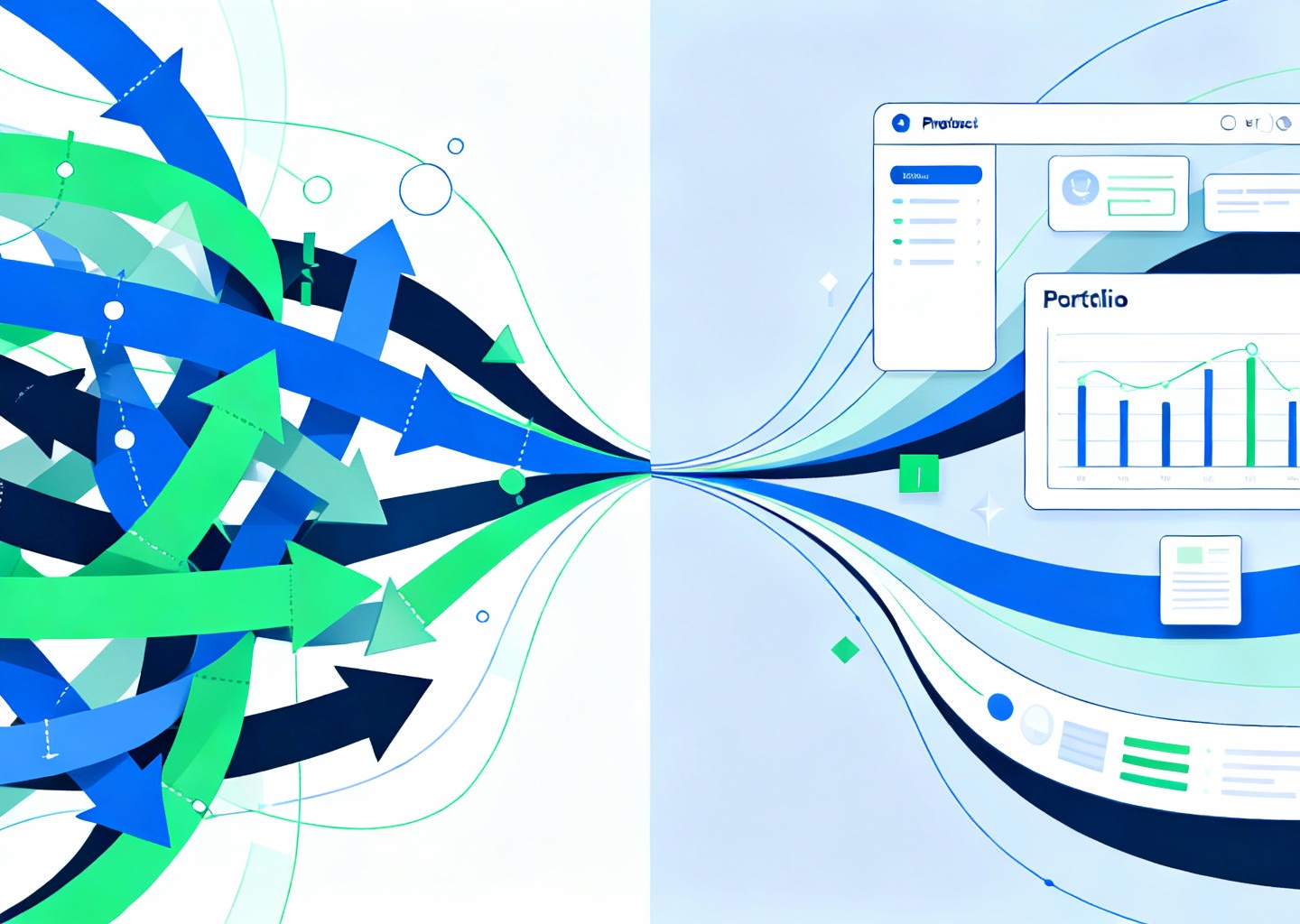

Transforming Project Chaos into Portfolio Success
A Practical Guide for Today's Portfolio Professionals
Portfolio chaos killing your delivery? Learn practical techniques to visualise work, eliminate low-value projects, and focus teams on finishing what matters most.
Transforming Project Chaos into Portfolio Success: A Practical Guide for Today's Portfolio Professionals
In the fast-paced world of modern business, portfolio professionals find themselves juggling countless projects, priorities, and stakeholder demands. The constant pressure to say "yes" to every new initiative creates a chaotic environment where nothing truly gets finished, quality suffers, and teams burn out. Sound familiar? There's a better way forward, and it starts with fundamentally changing how we think about project portfolios.
The Hidden Cost of Project Juggling
Most organisations suffer from what we might call "project proliferation syndrome" – the tendency to start new projects before finishing existing ones. This multitasking mindset feels productive on the surface, but it's actually destroying value. When teams constantly switch between projects, they lose momentum, create communication gaps, and accumulate what experts call "management debt."
Think about your current portfolio. How many projects are genuinely active versus merely started? The uncomfortable truth is that starting projects creates little value – finishing them does. Every project sitting in a half-completed state represents opportunity cost, tied-up resources, and delayed benefits to your customers.
As portfolio professionals, we need to shift our focus from project initiation to project completion. This means making hard choices about what gets our attention and what gets parked until we have genuine capacity to deliver quality results.
Making the Invisible Visible
The first step towards portfolio sanity is creating what's called a "Big Visible Chart" – a simple, visual representation of all work across your organisation. This isn't about sophisticated project management software; it's about transparency and shared understanding.
Start by collecting information on every type of work your teams handle. This includes the obvious projects, but also the hidden work that consumes capacity: periodic reports, ongoing support tasks, emergency fixes, and management activities. Many portfolio professionals are surprised to discover that "official" projects represent only a fraction of their teams' actual workload.
Create a timeline view that shows when each piece of work is happening. Use a whiteboard, sticky notes, or a simple digital tool – the format matters less than the visibility. This exercise alone will reveal conflicts, dependencies, and capacity constraints that weren't apparent when work lived in separate spreadsheets and systems.
The visual portfolio becomes your primary tool for strategic conversations. Instead of abstract discussions about priorities, you can point to specific timelines and ask concrete questions about trade-offs and resource allocation.
The Art of Strategic Elimination
Before you can effectively rank projects, you need to ask a more fundamental question: should we be doing this project at all? Every project in your portfolio should face a "commit, kill, or transform" evaluation. This isn't about being ruthless for its own sake; it's about being honest about value and opportunity cost.
Projects that made sense six months ago might no longer align with current strategic priorities. Market conditions change, customer needs evolve, and new opportunities emerge. Continuing a project simply because it's already started is a classic sunk cost fallacy that drains resources from more valuable initiatives.
The transformation option is particularly powerful. Sometimes a project's original scope no longer makes sense, but a smaller, focused version could deliver significant value much faster. Look for opportunities to extract the core value proposition and eliminate the peripheral requirements that are creating complexity and delay.
Collaborative Priority Setting
Ranking projects shouldn't be a solo decision-making exercise. The most effective portfolio professionals facilitate collaborative ranking sessions that bring together diverse perspectives and create shared ownership of the results.
One particularly effective technique is the point allocation method. Give stakeholders a fixed number of points (say, 10,000) to distribute across all projects based on their assessment of business value. This approach forces explicit trade-offs and moves the conversation away from "everything is important" to "here's what's most important relative to everything else."
Consider multiple ranking criteria beyond just financial returns. Projects might be ranked based on customer impact, strategic alignment, risk mitigation, or capability building. The key is making the criteria explicit and consistently applied across all initiatives.
Remember that ranking is not a one-time activity. As new information becomes available and circumstances change, rankings should evolve to reflect current reality rather than historical decisions.
Building Trust Through Transparency
Portfolio management is fundamentally a collaborative discipline. Success requires building relationships across departmental boundaries and creating trust through transparent decision-making processes. This means being open about your reasoning, sharing the constraints you're operating under, and inviting input from peers who may have different perspectives.
When discussing portfolio decisions, come prepared with principle-based reasoning rather than opinion-based arguments. Explain how your recommendations align with organisational strategy, customer value, or risk management objectives. This creates space for productive negotiation and compromise.
Transparency also means being honest about capacity limitations and trade-offs. If taking on a new priority means delaying an existing commitment, make that consequence explicit. This helps stakeholders make informed decisions rather than operating under the illusion that everything can be done simultaneously.
Creating Sustainable Rhythm
Your portfolio isn't a static document that gets updated annually during budget planning. It's a living tool that requires regular attention and adjustment. Establish a predictable cadence for portfolio review meetings – monthly or quarterly works well for most organisations.
These reviews should be structured to drive decision-making rather than just status reporting. Use a consistent agenda that evaluates progress on current initiatives, assesses new opportunities, and makes explicit commit/kill/transform decisions. This creates a sustainable rhythm that prevents the portfolio from drifting out of alignment with reality.
Between formal reviews, maintain awareness of changing conditions that might trigger an earlier reassessment. Market shifts, customer feedback, and technical discoveries can all signal the need to revisit portfolio priorities before the next scheduled review.
Measuring What Matters
Focus your measurement efforts on outcomes rather than activities. Track the delivery of valuable features or capabilities rather than adherence to original project plans. Velocity metrics – the rate at which your teams complete tested, deployable work – provide better insights than traditional milestone tracking.
Cumulative flow charts can help visualise work in progress and identify bottlenecks in your delivery pipeline. These visual tools make it easier to spot when too much work is being started relative to what's being finished.
Pay particular attention to obstacles and impediments that are slowing down delivery. Create an "obstacle report" that highlights systemic issues requiring management attention. This shifts the conversation from "why is this project late?" to "how can we remove barriers to faster delivery?"
Starting Your Portfolio Transformation
You don't need organisational mandate to begin improving your portfolio management approach. Start with your own sphere of influence, even if that's just a single team. The clarity and improved results that come from focused effort often create demand for broader adoption across the organisation.
Begin by visualising your current work, making explicit choices about priorities, and establishing a regular review rhythm. These simple changes will improve your team's performance and demonstrate the value of disciplined portfolio management to stakeholders and peers.
The transformation from project chaos to portfolio success isn't about implementing complex methodologies or sophisticated tools. It's about making work visible, focusing on finishing valuable initiatives, and creating sustainable practices that help your organisation deliver more value to customers while creating a healthier work environment for your teams.
Success in portfolio management comes from consistent application of these principles rather than perfect execution of complex frameworks. Start somewhere, measure the results, and iterate based on what you learn. Your future self – and your stakeholders – will thank you for taking the first step towards portfolio sanity.





